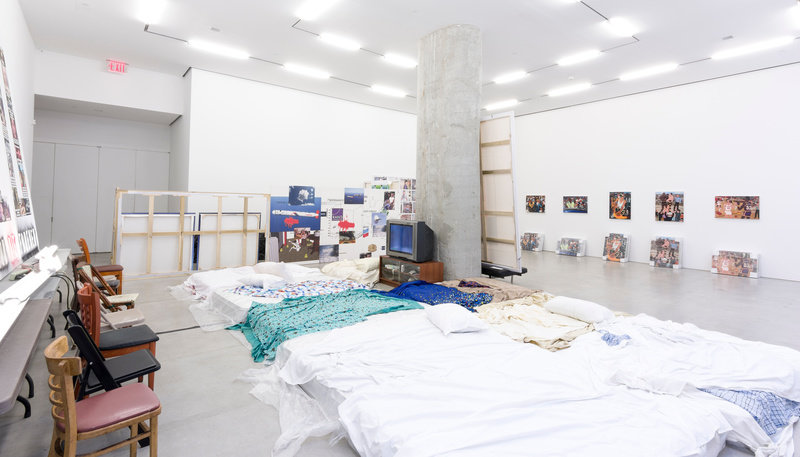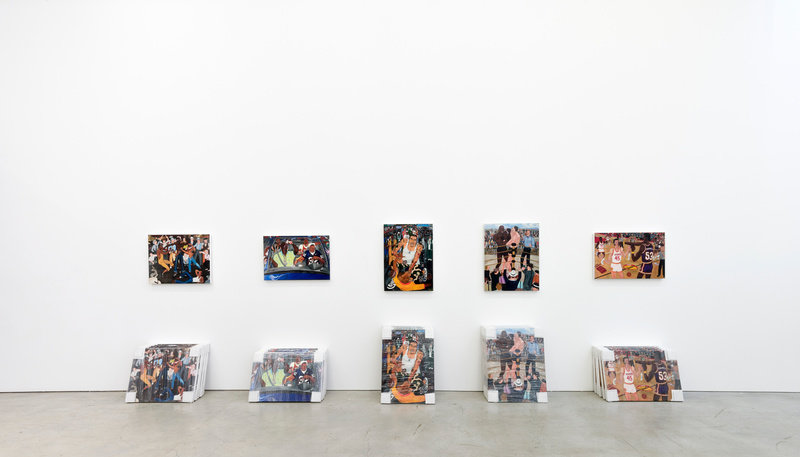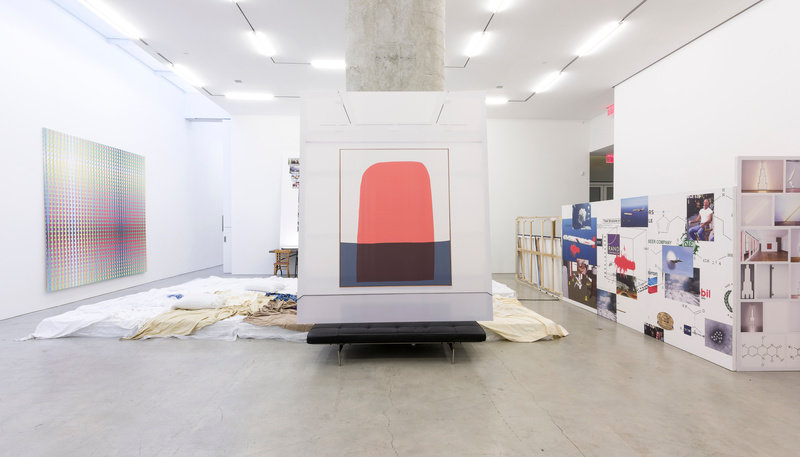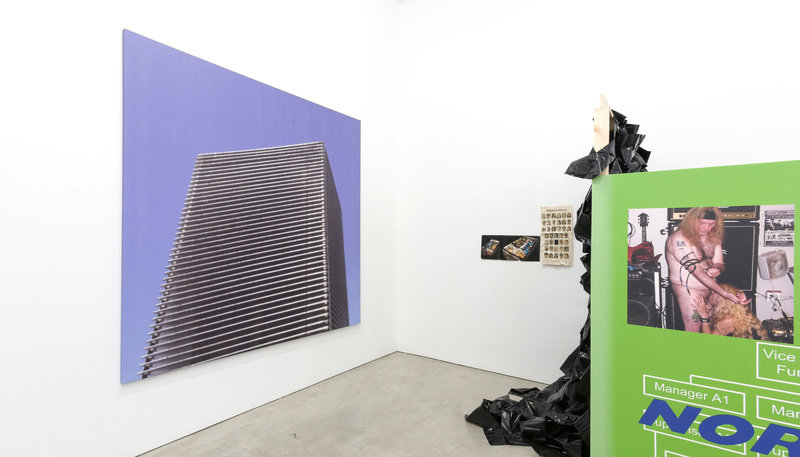All the artists in The Future is Ow currently live and work in Houston. All were part of the experimental gallery Mark Flood Resents. This gallery had a series of shows, in Chelsea and Miami Beach, that showed NFS art from Mark Flood’s personal collection. El Franco Lee had a solo show, Susie Rosmarin was part of the show Irrational Women, and Paul Kremer and Chris Bexar were featured in the show Emotionally Unavailable Men. Mark Flood wrote the press releases and paid the rent. The Future is Ow concerns the fact that all these artists make digitally printed paintings as part of their practice. The Future is Ow title is irrational, but it might be about people saying Ow! when they don’t get to look at their precious brushstrokes anymore.
Susie Rosmarin
Susie Rosmarin spent decades in New York painting her series of complexly colored rectilinear grids that dazzle the eye. Her Flash series orchestrates the phenomenon of optical flicker into spectacular and surprisingly evocative visual fireworks. Returning to Houston, she has lately worked with Kremer and Flood to computerize her process, and replaced months of labor intensive hand-painting with Command P to printers. She digitized the iconic Flash paintings, in works like Blue Yellow Red, and then wandered off on several new explorations. Grey and White takes color out of the grid equation, substituting an array of grey rectangles. Their subtle variance of size creates a fragile pattern which nonetheless carries feeling and meaning. Yellow partially dissolves Rosmarin’s grid into unfamiliar curves and biomorphic forms, and pure flat color is transformed into overlapping transparencies. These are surprising departures from Rosmarin’s former practice.
Mark Flood
Mark Flood is showing digitally printed works from several different series. Philatelic Rarity is from a series of prints that greatly enlarge the 1918 24 cent red and blue postal issue that was America’s first airmail stamp. Flood updated the stamp by substituting a Predator Drone for the Curtiss Jenny biplane originally featured. Philatelic Rarity recreates the error where a sheet of the stamps were printed with their centers upside down, creating the coveted Inverted Jenny variety. Executive Secretary and Seer are from a series of Viral Paintings where notorious and obscure internet images are thrown together into meaningful compositions. YOLO [AND THEN YOU DIE FOREVER] is from a series called the LOL Paintings. Giant letters spell out slang internet abbreviations like TLDR, AFK, and LOL. Each letter is composed of stacks of individual memes originated by the artist on the imgflip meme-generator site. These individual memes combine the verbiage of contemporary art theory with the intense visuals of viral net imagery, for disturbing and humorous effects. The exhibition also includes a video by Mark Flood, created in 2012 in NYC, in which Adam Rodriguez reads Flood’s poem White Cube. The content of the poem is relevant to the design of the exhibition. Rodriguez is well known from CSI: Miami, Empire and Magic Mike XXL.
Paul Kremer
Paul Kremer’s artistic production oscillates between digitally printed meditations on the internet, and massive zombie abstractions that have been compared to IKEA potholders. The Future is Ow features several of Kremer’s IMG_SRCH paintings which consist of fragments of Google image searches printed out on canvas. Examples include Portage County, and Flavin Diagram, both of whose titles are also the search terms used. Nowadays, Google searches are as familiar as breathing, but when hung on a wall for contemplation, the poetry of these assembled images becomes apparent. These works continue a tradition of arranging found mass-media imagery into meaningful compositions, a tradition that includes Joseph Cornell, Robert Rauschenberg and Dada collage. Another work of Kremer’s, Mock-up, comes out of his practice of creating images where famous works of art are photoshopped into inappropriate environments. These pictures are accumulated on his notorious site Great Art in Ugly Rooms. Mock-up shows one of Kremer’s abstractions posed monumentally in a museum interior. It speaks to the alarming blur between real success pictured on the net, and ...fake pictures on the net.
Chris Bexar
Chris Bexar photographs tiny digital components in the bright Houston sun, against the bright Houston sky, and then manipulates the images into imaginary urban skylines, which he prints on canvas. In our digital environment, there is a fractal relationship between the tiny structures and the enormous structures. Everything looks the same. Blow up the components of a PC, and they look like the Houston skyline. Take an aerial photo of the Metropolis, and it looks like the guts of your iPhone. A problem Bexar has is that his imaginary buildings look so familiar, viewers assume he just took photos of real buildings. In works like Shut Down, Bexar has begun populating his imaginary city with strange digital/human creatures assembled out of the flotsam and jetsam of internet surfing. Bexar also makes videos that zoom in and out of defamiliarized cities, made out of distorted Google maps imagery. These videos come with voiceovers discussing the peculiar problems of artists and collectors today. The Future Is Ow includes his video, Become A Digital Artist.
El Franco Lee II
El Franco Lee II has developed a unique figural painting style out of his early work with the graphic novel. He illustrates mythic moments, usually from African American cultural history. These incidents are often curiously re-imagined and sometimes contain unexpected fantasy elements. Three El Franco Lee images from the show exemplify his concerns and techniques. The Great White Hope presents the infamous 1910 boxing match where Jack Johnson easily defeated world heavyweight champ James Jefferies, who had been called out of retirement by novelist Jack London’s pleas for a “great white hope” to secure the title for white people. Lee captures the violent racism that swirled around the event by highlighting spectators flipping off Johnson, and by featuring a racist sign in the crowd. Rudy T. vs Kermit Washington shows the fateful moment when Kermit Alan Washington punched Rudy Tomjanovich in a multi-player brawl during a 1977 basketball game between the LA Lakers and the Houston Rockets. An endless wave of consequences and controversy flowed out of this punch and both men's careers were never to recover. El Franco Lee’s precise rendering of a frozen moment couldn’t be more different in feel than the blurred black-and-white video captures that documented the event. He presents the viewer a dreamlike meditation on an infinitely meaningful reality, carefully constructed to convey the artist’s relevant ideas and emotions.
Then there's Lil’ Flip vs T.I., a vivid image of a 2004 brawl between Atlanta rapper T.I.and Houston rapper Lil’ Flip in Cloverland, Texas. Although the beef between the rappers was real enough, its difficult to say whether this legendary fight actually occurred, as the event is shrouded in rumors and conflicting accounts. Lee apparently has his own convictions about what happened, because there is no ambiguity in his powerful painting, so full of carefully articulated details, apparently drawn from life. Lee boldly goes thru the pages of history, never shying away from violence or the grotesque, and not hesitating to invent and re-imagine for artistic effect. The result is a stream of brilliantly original images that stand out, in an art-world full of appropriations, political correctness and tastefully muted statements on race. Lee has also approached his career in an original way. One of his choices was to make digital reproductions, on canvas, of some of his paintings, and to sell these at lower prices. These reproductions were made with the commercial Giclee process.
The Future Is Ow Exhibition Design
The Future is Ow makes an attempt to extend and distort the usual white cube gallery exhibit strategy. Of course, rejecting the white cube is itself a cliche. Everybody hates the white cube, but let’s review why. It’s because it makes the art world look like a lab where disinterested scientists with no issues are looking at a sterilized specimen. Because it makes art look like one more item on an endless schedule of items. Because it drains the meaning out of the art by creating an atmosphere of Nothing really matters here because authority figures have already figured everything out. Etc. For further information see the White Cube poem/ video. Even though the show title mentions The Future, I decided not to try to make Marlborough into some futuristic movie set because... Why bother? I evoke the Future more as an improvised refugee center with a lot of crummy furniture and TVs for people to watch so they don’t get too restless. That sounds a lot like how the Mark Flood Resents gallery was set up, so I include some of the black plastic lattices that gallery used. They control light and visual access.
And speaking of light, I like to exhibit paintings in dark rooms, as I understand Rothko did. One’s eyes adjust and there’s less of a feel of police interrogation of the object, and more of a sense of discovery. Bad lighting is good, because bad lighting is the only lighting that people notice.
In a spirit of dejected misadventure, the Future Is Ow takes a lot of the paintings off the wall and uses them as walls to create little huts where people can hang out, and watch videos.
One of these huts is hung with hundreds of ancillary works created by the artists as they work toward the digital printed paintings in the show. This hut is for the intrepid viewer who wants to go deeper, and also to trap those who wish to survey the show quickly.
I like exhibitions to have a rabbit hole that is too deep for viewers to ever reach the bottom. Thanks,
Mark Flood, 2016
Works
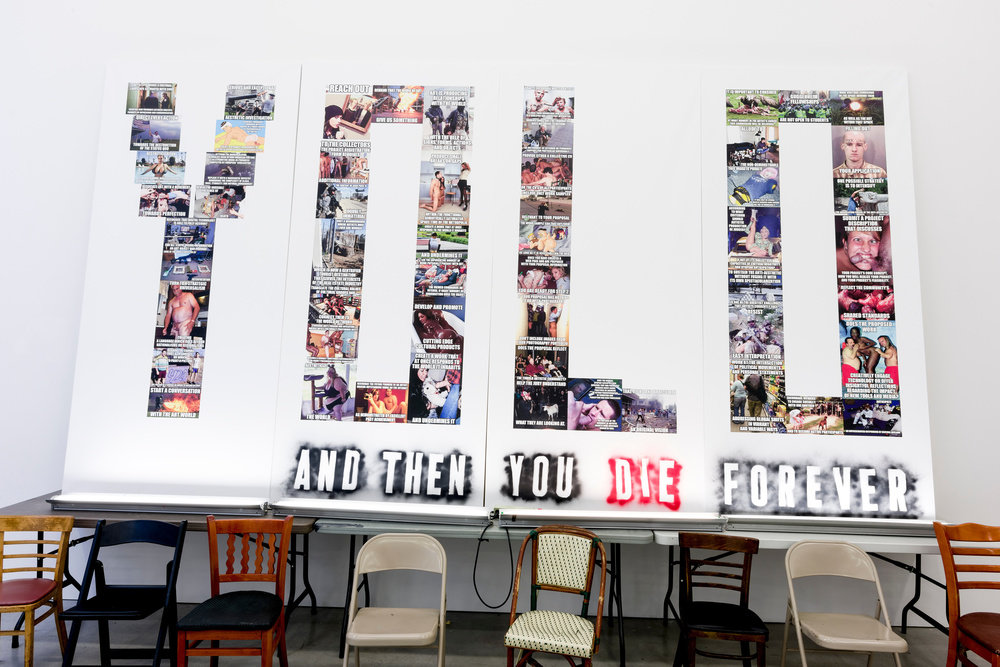
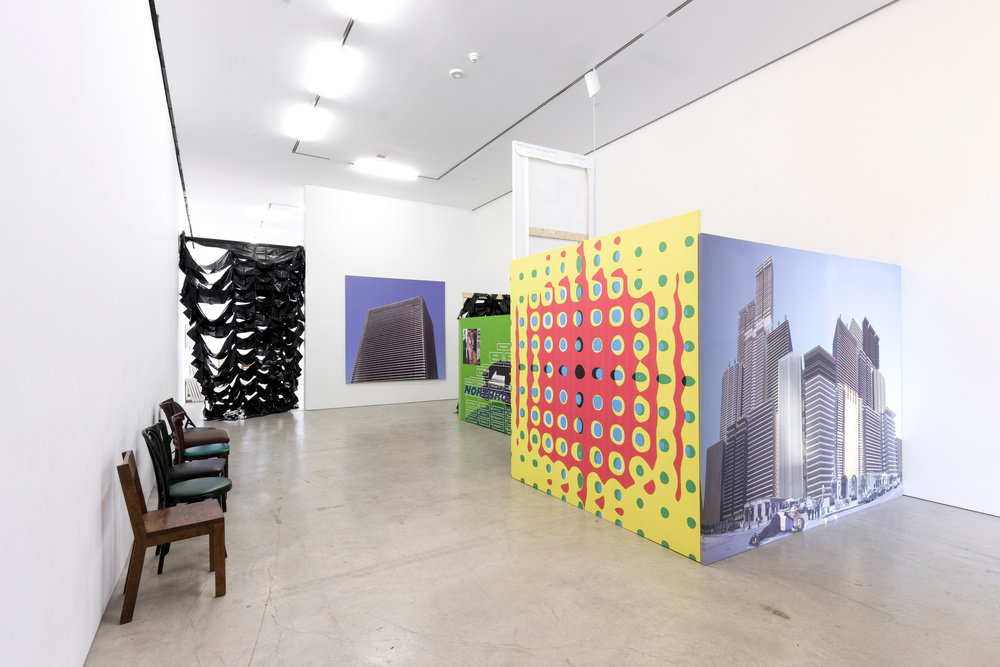
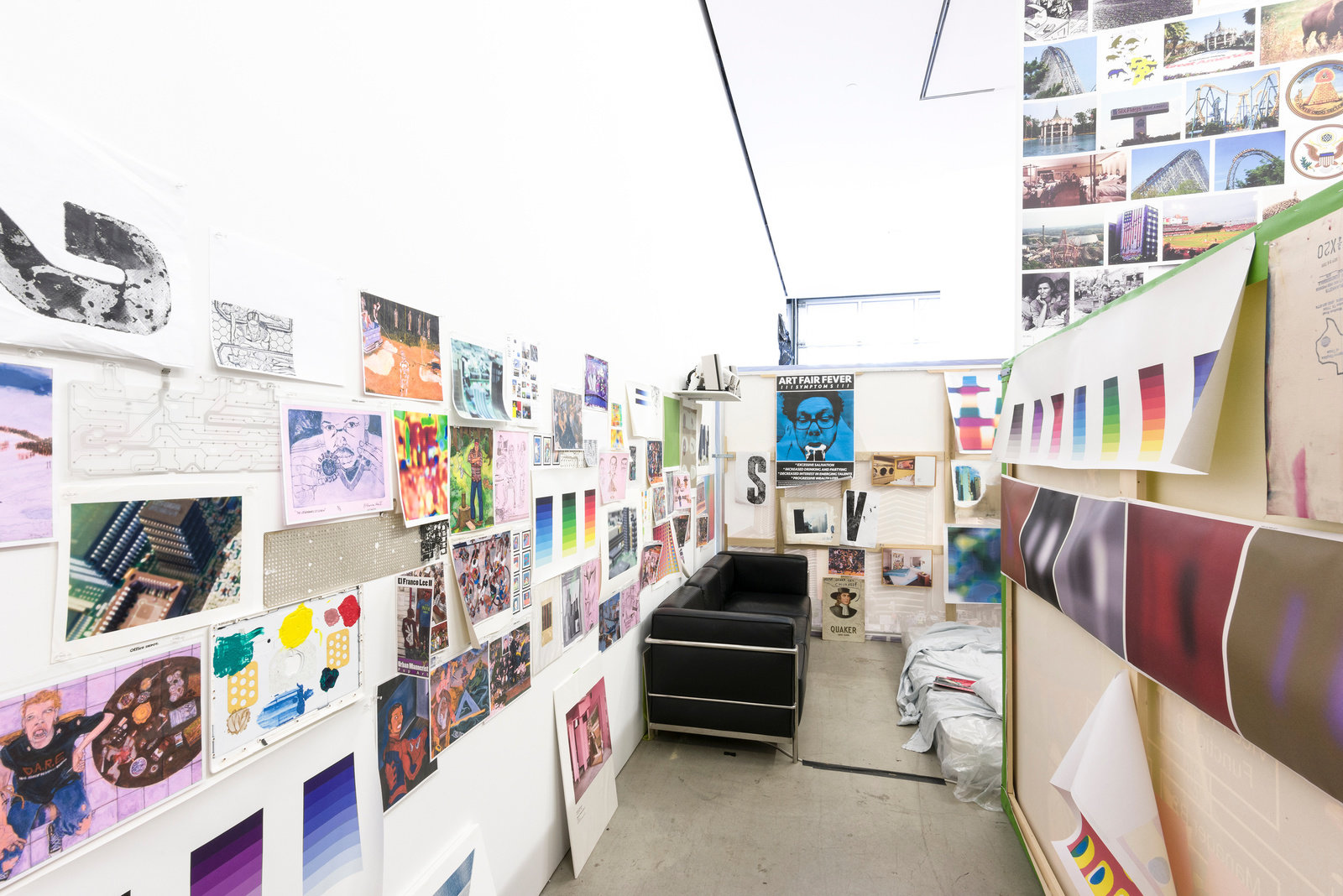
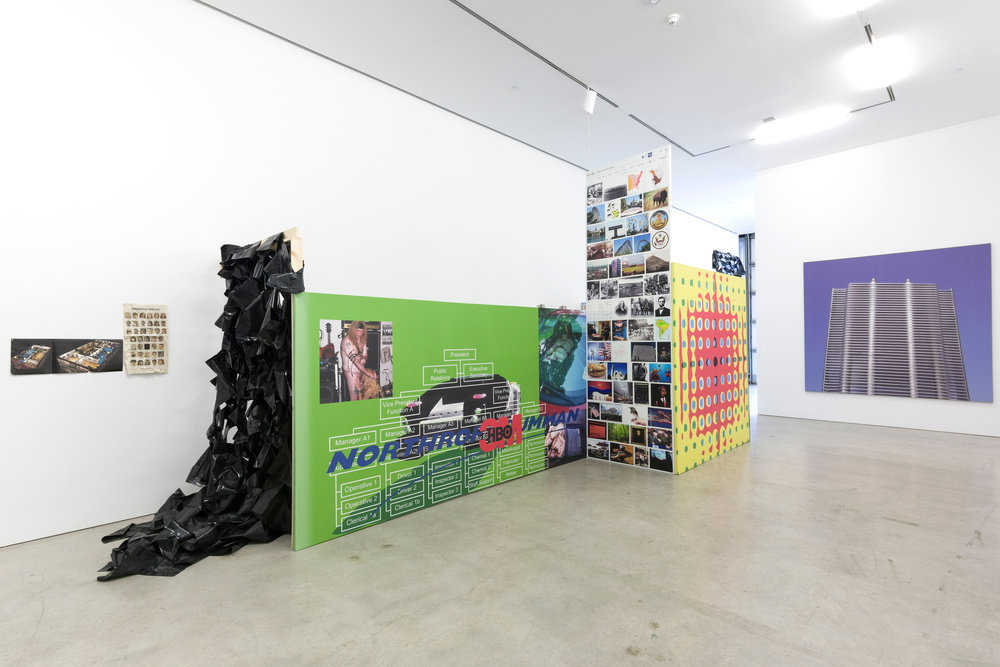

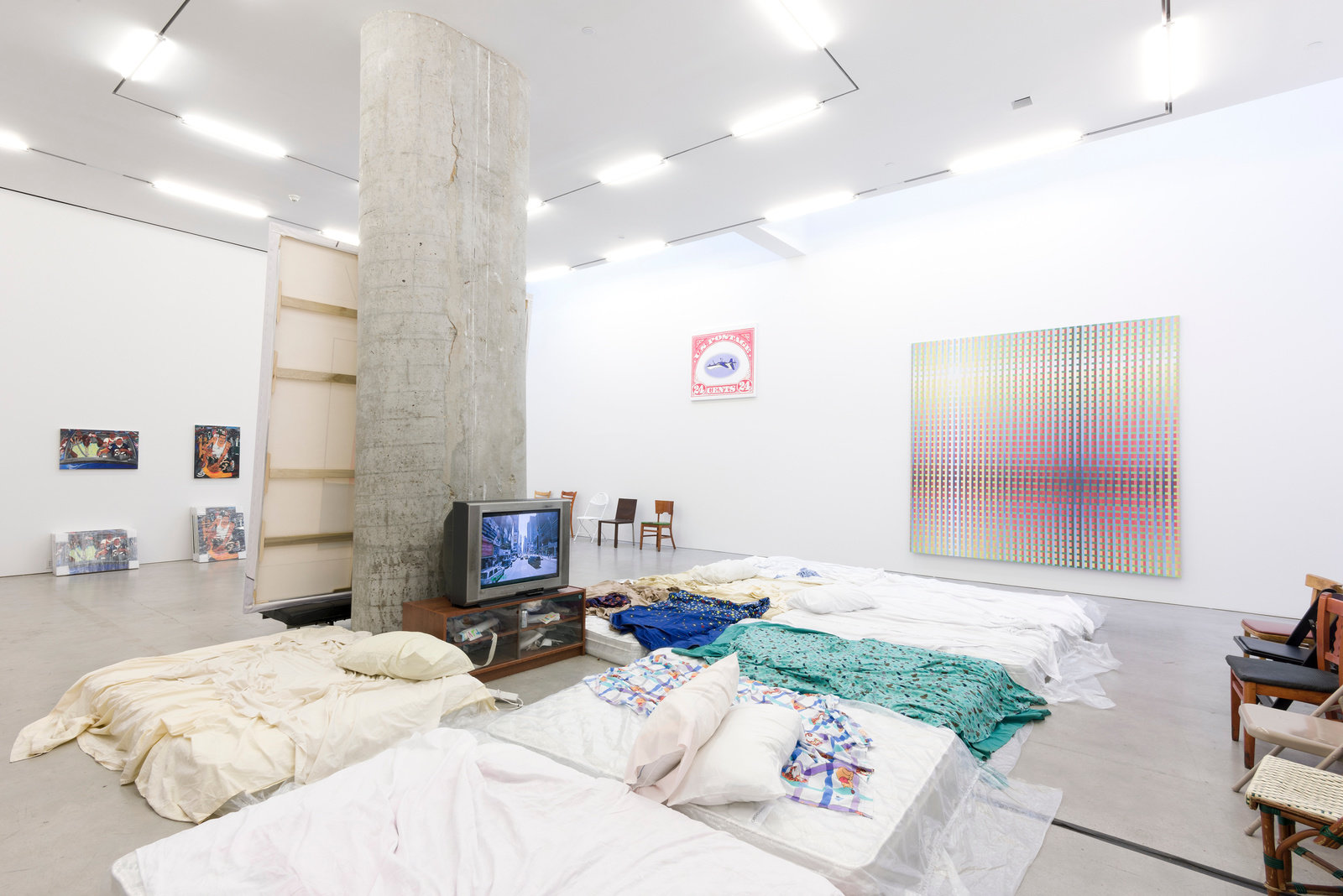
Press
